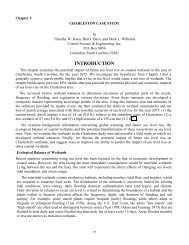A GEM Detector System for an Upgrade of the CMS Muon Endcaps
A GEM Detector System for an Upgrade of the CMS Muon Endcaps
A GEM Detector System for an Upgrade of the CMS Muon Endcaps
You also want an ePaper? Increase the reach of your titles
YUMPU automatically turns print PDFs into web optimized ePapers that Google loves.
Figure 34: Exploded view <strong>of</strong> a Triple-<strong>GEM</strong> arr<strong>an</strong>gement (Dist<strong>an</strong>ces are not to scale)<br />
4.2 Study <strong>of</strong> <strong>the</strong> tr<strong>an</strong>sport parameters<br />
In this section, we present studies <strong>of</strong> <strong>the</strong> tr<strong>an</strong>sport parameters <strong>for</strong> two gas mixtures, (Ar/CO2/CF4) <strong>an</strong>d (Ar/CO2)<br />
in <strong>the</strong> ratios 45 : 15 : 40 <strong>an</strong>d 70 : 30 respectively. Some discussions on tr<strong>an</strong>sport properties in gaseous detectors<br />
c<strong>an</strong> be found here[20]. Recently <strong>GEM</strong> detectors have been operated withAr/CO2/CF4 successfully in a high rate<br />
environment in <strong>the</strong> LHCb experiment[18], <strong>an</strong>d with Ar/CO2 in a 70 : 30 ratio in <strong>the</strong> TOTEM experiment[13].We<br />
are investigating <strong>the</strong> usage <strong>of</strong> Ar/CO2/CF4 as this gas combines a high drift velocity along with a small Lorentz<br />
<strong>an</strong>gle (almost comparable toAr/CO2), which will be useful <strong>for</strong> triggering <strong>an</strong>d o<strong>the</strong>r physics studies in <strong>the</strong> <strong>for</strong>ward<br />
region. Also, this gas was found to give a better time resolution <strong>of</strong> ∼ 5 ns as compared to Ar/CO2 which gave a<br />
time resolution <strong>of</strong>∼ 10 ns [18]. We do a feasibility study <strong>of</strong> <strong>the</strong>se gas mixtures <strong>for</strong> <strong>the</strong> <strong>CMS</strong> scenario. Since <strong>CMS</strong><br />
has a magnetic field <strong>of</strong> 4 T in particular, we would like to study <strong>the</strong> effect <strong>of</strong> <strong>the</strong> magnetic field <strong>an</strong>d <strong>the</strong> effect <strong>of</strong><br />
<strong>the</strong> <strong>an</strong>gle between <strong>the</strong> E-field <strong>an</strong>d B-field.<br />
When electrons <strong>an</strong>d ions in a gas are subjected to <strong>an</strong> electric field, <strong>the</strong>y move on <strong>an</strong> average along <strong>the</strong> electric field,<br />
but individual electrons deviate from <strong>the</strong> average due to scattering on <strong>the</strong> atoms <strong>an</strong>d molecules <strong>of</strong> <strong>the</strong> gas. Scattering<br />
leads to variations in velocity, called longitudinal diffusion, <strong>an</strong>d to lateral displacements, called tr<strong>an</strong>sverse<br />
diffusion. The scattering process in each direction c<strong>an</strong> to a good approximation be considered Gaussi<strong>an</strong> on a microscopic<br />
scale. Electric field affects <strong>the</strong> tr<strong>an</strong>sverse <strong>an</strong>d longitudinal diffusion differently <strong>an</strong>d so <strong>the</strong> two coefficients<br />
are plotted separately in <strong>the</strong> figures. In cold gases like carbon-dioxide <strong>for</strong> example, <strong>the</strong> diffusion is small, while<br />
drift velocity is low <strong>an</strong>d unsaturated <strong>for</strong> values <strong>of</strong> electric fields which are usually used in gas detectors. Warm<br />
gases like argon on <strong>the</strong> o<strong>the</strong>r h<strong>an</strong>d, have a higher diffusion, but when <strong>the</strong>y are mixed with polyatomic/org<strong>an</strong>ic gases<br />
having vibrational <strong>an</strong>d rotational modes, diffusion is reduced in most cases, while <strong>the</strong> drift velocity is increased.<br />
Fig. 35 shows <strong>the</strong> diffusion coefficients <strong>for</strong> two gas mixtures as a function <strong>of</strong> <strong>the</strong> electric field. As c<strong>an</strong> be seen<br />
from <strong>the</strong> plot, <strong>the</strong> diffusion in <strong>the</strong> mixture Ar/CO2/CF4 is lower, as expected, because <strong>of</strong> a higher polyatomic<br />
gas component; both CF4 <strong>an</strong>d CO2 having vibrational modes which contribute to lowering <strong>the</strong> diffusion. CF4<br />
is adv<strong>an</strong>tageous to use in a high-rate environment because <strong>of</strong> its high drift velocity but it suffers from electron<br />
attachment. There<strong>for</strong>e CO2 is used to “cool” <strong>the</strong> electrons <strong>an</strong>d reduce <strong>the</strong> electron attachment which occurs in<br />
CF4.<br />
36
















